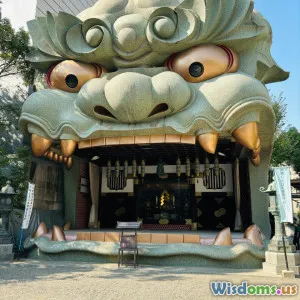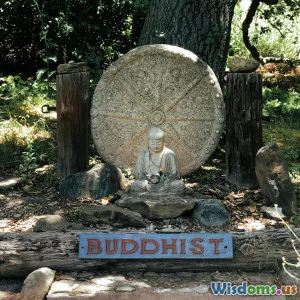
Lessons From Japanese Kami Spirits for Everyday Resilience
8 min read Explore timely resilience lessons from Japanese kami spirits, offering wisdom for daily strength and mental balance. (0 Reviews)
Lessons From Japanese Kami Spirits for Everyday Resilience
In a fast-paced and often chaotic world, resilience has never been more crucial. While sources for inspiration abound, some of the most profound lessons come from ancient spiritual traditions. The Japanese kami, divine spirits revered in Shinto, offer timeless wisdom that transcends culture and era. These spirits embody natural forces, emotions, and facets of life, providing a rich metaphorical framework for building everyday resilience.
This article explores how the characteristics and stories of Japanese kami can inspire practical resilience strategies. By understanding and internalizing these lessons, individuals can cultivate emotional strength, mental balance, and social harmony in the face of daily adversities.
Understanding Kami: Nature Spirits With Profound Wisdom
Kami (神) in Shinto belief are guardians, embodiments of nature's power, virtues, and sometimes ancestors. Unlike anthropomorphic gods in many Western mythologies, kami often represent elements like wind, water, mountains, and fertility or abstract concepts such as growth and harmony. They are respected not as omnipotent creators but as essential forces interconnected with humans.
This interconnected worldview emphasizes coexistence and balance, reflecting a resilience model where adaptation and harmony with one’s environment are key. Examples include:
- Amaterasu, the sun goddess, representing light and renewal.
- Fujin, the god of wind, symbolizing change and invisible but perceptible force.
- Inari, deity of rice, prosperity, and fertility, highlighting nurturing and growth.
These kami personify qualities we can emulate to build resilience.
Embracing Impermanence with Amaterasu: The Power of Renewal
The myth of Amaterasu’s retreat into a cave brings profound lessons about handling personal darkness or crises. In the story, the sun goddess hides following conflict, plunging the world into darkness until the other kami lure her out.
Lesson: Everyone faces periods of withdrawal or hardship. Like Amaterasu, one must recognize these as natural cycles rather than permanent states.
-
Practical takeaway: When overwhelmed, permit yourself rest and reflection instead of denying emotions. This pause creates space for renewal and rediscovery of inner light.
-
Real-world example: Modern psychology emphasizes acceptance and mindfulness to build resilience. Amaterasu’s story parallels embracing feelings with the certainty they will pass.
This teaches that resilience is not nonstop strength but the capacity to rebound after moments of vulnerability.
Adapting Through Change with Fujin: Navigating Invisible Forces
Fujin, the wind god, embodies unseen energy shaping the environment. Wind brings change—sometimes gentle, sometimes turbulent. His capricious nature reflects life’s unpredictability.
Lesson: Resilience involves adaptability, responding fluidly to shifting circumstances rather than resisting them.
-
Practical takeaway: Cultivate flexibility in thought and action. Recognize when circumstances are beyond control and focus on what you can adjust.
-
Data insight: Organizations with adaptable cultures are 3x more likely to outperform peers during crises (McKinsey, 2020).
-
Example: A person facing job loss might leverage this adaptability to explore new careers rather than resist change.
By following Fujin’s example, resilience becomes a dance with change rather than a battle.
Fostering Community and Support with Inari: The Spirit of Growth
Inari, commonly associated with rice and prosperity, reflects abundance that stems from nurturing and cooperative effort.
Lesson: Resilience is not solely individual but deeply social. Building strong support networks nourishes wellbeing much like cultivating fertile land yields a rich harvest.
-
Practical takeaway: Invest time in relationships and seek mutual support. Share burdens and resources like communities do in festivals honoring Inari.
-
Quote: As Japanese scholar Motoori Norinaga said, “Harmony (wa) is the basis of a healthy society.”
-
Real-world insight: Studies show social support reduces stress and boosts recovery from trauma (APA, 2019).
Drawing on Inari’s example reminds us resilience flourishes within connected communities.
The Spirit of Simplicity and Purity: Lessons from the Nature of Kami
Kami live in simple, natural forms—shrines are often modest and beautiful in their minimalism. This aspect encourages a minimalist approach to life and mental clutter.
Lesson: Simplifying one’s environments and priorities enhances focus and resilience.
-
Practical tip: Declutter spaces and mindsets to reduce overwhelm.
-
Psychological finding: Feng Shui and minimalist living positively affect mental clarity and reduce anxiety (Journal of Environmental Psychology, 2018).
Simplifying is akin to making space for resilience to grow, much as a calm forest floor nurtures seedlings.
Conclusion: Integrating Kami Wisdom in Daily Life
Japanese kami spirits offer more than mystical lore; they present a blueprint for resilience rooted in balance, adaptability, renewal, and communal support. By embracing the lessons of Amaterasu’s renewal, Fujin’s adaptability, Inari’s nurturing spirit, and the purity embodied in kami shrines, we can cultivate a holistic resilience suited for our contemporary challenges.
In practical terms, this means recognizing our vulnerabilities and resting when needed, adapting gracefully to change, fostering supportive relationships, and simplifying life’s complexities. Just as the kami sustain harmony between natural forces and humans, we can harmonize our inner and outer worlds to thrive, no matter the storms we face.
“In the embrace of the kami’s wisdom, resilience is not merely surviving adversity—it is flourishing through it.”
By integrating this ancient spiritual wisdom, you empower yourself with resilient tools that are both timeless and deeply practical. Consider adopting these lessons today for a more balanced and resilient journey through life.
References:
- McKinsey & Company, “Organizational Resilience in a Post-Pandemic World,” 2020.
- American Psychological Association, “Social Support Acts as a Buffer Against Stress,” 2019.
- Journal of Environmental Psychology, “The Psychological Benefits of Minimalist Lifestyle,” 2018.
- Motoori Norinaga, Japanese Scholar, on social harmony.
Rate the Post
User Reviews
Popular Posts




















